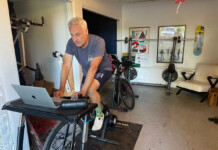By Pat Casey — In case you hadn’t noticed, winter is upon us. For those of us in higher elevations, normal training roads are probably becoming questionable and wet. The days are getting shorter, and many of us are transitioning to indoor riding until that long-awaited desert training camp. Maybe you’re adding some strength work to prepare for ski season or to lay the foundation for long winter base miles. As you migrate inside, the nature of your riding will change from the dynamic, terrain-driven variability that the road presents, and riding becomes a bit more static and stationary. It’s not uncommon for riders begin to notice new sensations when they transition to being indoors.

As you’re making changes to your training, and you’re allowing space to adapt to new stimuli, you might consider getting your bike fitted, or re-fitted this winter. Let’s discuss why getting your bike fitted this winter is a smart move and how it’s all about you – your body, your style, and even those annoying previous injuries that might affect your movement and patterns more than you realize.
- What does it mean to be ‘optimized’?
- There is not a template or a formula for a great bike fit. Each bike fit session should consider an athlete’s goals, history, and most importantly, the quality of their movement, and current limitations.
- Optimized for what? Comfort? Aerodynamics? Endurance? Are you racing IRONMAN, or local Sprint and Olympic distance races? Are you racing hill climbs, or criteriums? Do you want to race gravel, or just explore on gravel roads with your friends? These are questions that we hope to answer as you and your fitter embark on the road towards a more appropriate position for you, your body, and your goals.
- Gearing Up for the 2024 Season
- Improve your capacity by helping you produce more watts without placing more demand on your metabolic or musculoskeletal system.
- Improve your technique through improved biomechanical accuracy. This allows you to home in on the purpose of each session, especially as you target different cadence ranges in your training throughout the winter.
- Why Winter? Why Not!
- Time spent on indoor training can feel more arduous than it needs to be if you’re not comfortable. Getting your fit dialed in over the winter will make training feel much more attainable.
- Adjust and Adapt: Most fitters encourage a follow up as part of your bike fit service. After a month or two of riding a new position, you might want some tweaks to the position. They expect to see you again and especially appreciate adherence to the movements suggested to address your limitations identified in the first session.
- Long-Term Riding Comfort
- Along with your dynamic measurements like knee extension, reach, and knee tracking, the major contact points take precedent in the fitting process as well. This means saddle selection, insoles, and possible shims to accommodate anatomical characteristics, and handlebar interfaces like how your hoods are positioned, how the tape is layered around your shifter, and where your hands like to land while riding.
- Posture, balance, and stability are three overarching themes to fit, and not only will you leave with a renewed sense of what this means for you, but adhering to a consistent routine of exercises and movement will help you adapt to any changes in position, as well as manage issues you might be experiencing.
- Fitting Tools and Applied Technology – No “Eyeballing”
- There are several reasons why fitters leverage technology in a fitting process. Mainly, this is meant to help objectify measurements, and collect pre-fit data to help guide the process. Measurable data points in knee tracking, hip stability, and pelvic rotation are not visible, even to the most trained eyes. So, utilizing data to analyze details is crucial to a great bike fit.
- Bike fitting should be driven by objective measurements, an honest movement screening, and subjective feedback to help drive the process forward. Rather than a “one size fits all” philosophy which might try to force you into a riding position that might look good in a vacuum but is not conducive to your goals or for long term growth as a cyclist or triathlete.
Ready to get dialed in? Winter doesn’t have to be a downtime for your cycling. Consider getting a fit if you’re looking for some marginal gains this off season, and especially if you’re looking to manage aches and pains while riding and hoping to enjoy riding even more when Spring rolls around!








